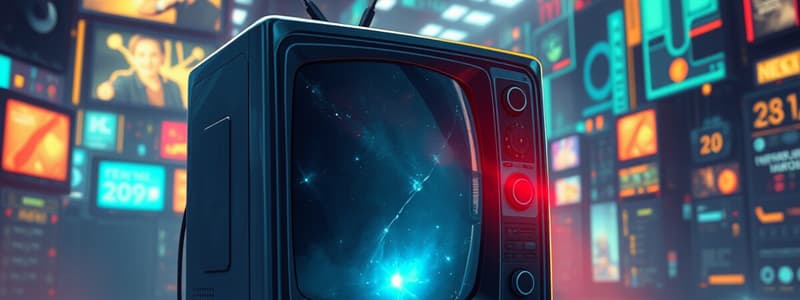Podcast
Questions and Answers
What are the main elements required for TV to work? (Select all that apply)
What are the main elements required for TV to work? (Select all that apply)
- Speaker
- Video Source (correct)
- Transmitter (correct)
- Receiver (correct)
What is a video source?
What is a video source?
It is the image or program, such as a TV show, news program, live feed, or movie.
What is the role of a transmitter in television broadcasting?
What is the role of a transmitter in television broadcasting?
A transmitter broadcasts both video and audio signals over the airwaves.
What does a receiver do in a TV set?
What does a receiver do in a TV set?
Which of the following can be types of display devices? (Select all that apply)
Which of the following can be types of display devices? (Select all that apply)
What are the three major ways to receive television broadcasts?
What are the three major ways to receive television broadcasts?
What is Broadcast Television?
What is Broadcast Television?
How does Satellite TV transmit its signals?
How does Satellite TV transmit its signals?
What is required for audio sources in TV programming?
What is required for audio sources in TV programming?
Flashcards are hidden until you start studying
Study Notes
Introduction to Television Technology
- Television function relies on multiple technologies and processes to deliver programming to viewers.
- Key elements include video sources, audio sources, transmitters, receivers, display devices, and sound devices.
Video and Audio Sources
- Video Source: Represents the image or program (TV shows, news, live feeds, or movies), typically recorded by a camera.
- Audio Source: Accompanies video and can be mono, stereo, or processed for surround sound.
Transmission of Signals
- Transmitter: Sends free TV signals from broadcast companies to viewers, converting audio and video signals into radio waves.
- Transmitters can broadcast multiple channels simultaneously over the airwaves.
Receivers and Display Devices
- Receiver (TV set): Captures radio waves from transmitters and converts them back to audio and video signals for playback.
- Display Device: Converts electrical signals into images; commonly a TV set, but can also be a monitor.
Types of Display Technologies
- Standard TV sets often feature cathode ray tubes (CRT).
- Newer technologies include LCD (liquid crystal display) and plasma displays.
Sound Devices
- Most TVs come with built-in speakers for audio output, aligning sound with video.
- Many modern TVs support external high-quality speakers, enhancing audio performance.
Surround Sound Technology
- TVs can send audio signals to multiple speakers around a room, creating an immersive surround sound experience.
Methods of Receiving TV Signals
- Three primary means to access television broadcasts: Broadcast TV, Cable TV, and Satellite TV.
Broadcast Television
- Broadcast TV: Signals transmitted from terrestrial transmission towers, often provided free for anyone with a receiver.
- Benefits from specific radio frequencies, allowing high-quality transmission with minimal interference and the capability to penetrate structures.
Satellite Television
- Utilizes signals from satellites in orbit rather than ground-based transmission.
- Satellite transmissions are typically digital, encoded, and compressed for effective delivery.
Studying That Suits You
Use AI to generate personalized quizzes and flashcards to suit your learning preferences.





